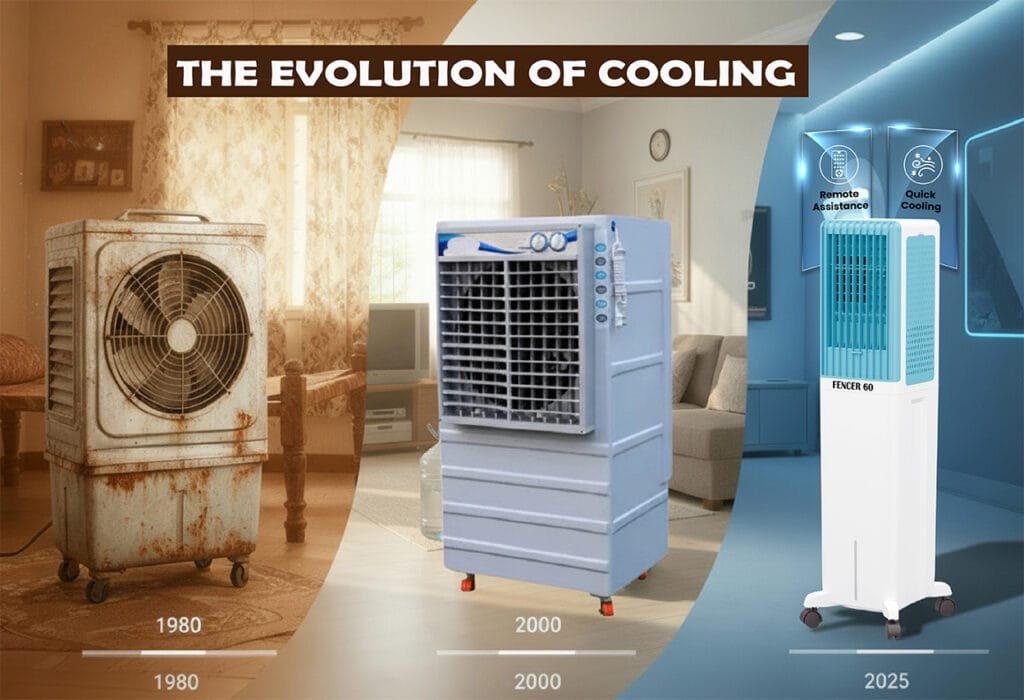India’s climate has always demanded practical and affordable cooling solutions, especially in regions where summers are long, dry, and intense. Before the era of air conditioners and sophisticated cooling systems, homes relied on natural ventilation, desert winds, and makeshift cooling arrangements to combat the heat. With rapid urbanization and rising temperatures, the need for a reliable indoor cooling solution grew significantly. It was in this environment that air coolers emerged as one of the most accessible and energy-efficient ways to stay comfortable. What began as simple metal-body coolers decades ago has evolved into a multi-billion-rupee industry with smart, sleek, and eco-friendly models that cater to modern lifestyles. The evolution of air coolers in India is a story of innovation, engineering excellence, and continuous adaptation to the needs of Indian consumers.
The Early Era of Metal-Body Coolers
The earliest air coolers in India were built using galvanized metal sheets, giving them a sturdy but heavy structure. These units operated on the basic principle of evaporative cooling, with wood wool pads, a high-powered fan, and a water tank to circulate cool air. For many years, these metal-body coolers dominated the market because they were durable, locally repairable, and effective in dry climates. They became a popular household solution, especially in North and Central India.
However, these coolers also had limitations. Their metal bodies were prone to rust, which reduced lifespan and required frequent repainting and maintenance. Noise levels were often high, and water leakage was common due to metal corrosion. The overall design lacked aesthetic appeal and safety features. Despite these shortcomings, metal coolers set the foundation for what would later become a transformative shift in the industry.
Shift to Plastic Body Coolers
The introduction of plastic-body coolers marked a turning point in the Indian cooling industry. With advancements in molding technology and increased availability of high-quality polymers, manufacturers transitioned from metal to high-impact plastic. This shift brought a new era of durability, as plastic bodies were rust-free, leakage-resistant, and long-lasting. These coolers also became lighter, more portable, and visually appealing, fitting better into modern home aesthetics.
Beyond durability and design, plastic coolers offered improved safety. Rounded edges, shock-proof bodies, and standardized electrical components made them more reliable for everyday household use. Companies also began experimenting with different sizes and styles from compact personal coolers to large desert coolers for halls and commercial spaces. This transition expanded the market, making modern air cooler technology accessible to homes, offices, and shops alike.
Technological Advancements in the Last Two Decades
The past twenty years have witnessed remarkable technological evolution in air coolers in India. With growing competition and increasing consumer expectations, manufacturers introduced innovations that not only enhanced cooling performance but also improved energy efficiency and user convenience.
The replacement of traditional wood wool with honeycomb cooling pads was one of the first major upgrades. Honeycomb pads offered superior water absorption, longer life, and more efficient cooling due to their structured, hexagonal design. They reduced maintenance and delivered consistent performance.
Simultaneously, motors evolved from basic induction motors to BLDC motors, which consume significantly less power while providing higher efficiency. A BLDC air cooler not only cuts electricity usage by up to 60% but also operates quietly, making it ideal for bedrooms and long hours of use.
Improvements in fan engineering led to low-noise, aerodynamic blades and high-airflow designs capable of cooling larger rooms quickly. Many modern coolers now feature multi-speed controls, auto-swing functions, and enhanced air-throw capacity that rivals entry-level air conditioners.
User-friendly features such as water level indicators, auto-fill systems, and ice chambers further boosted convenience. Consumers could now enjoy continuous cooling without manual intervention, making air coolers far more practical for daily use.
Rise of Smart Models
As India entered the digital and IoT era, air coolers followed suit. The latest generation of coolers is increasingly equipped with smart features, turning them into sophisticated home appliances rather than basic cooling devices. Today’s smart air cooler models offer WiFi connectivity, app-based control, and compatibility with voice assistants like Google Assistant and Alexa.
Digital displays simplify monitoring temperature, humidity, and airflow settings, while remote controls allow convenient adjustment from anywhere in the room. Enhanced inverter compatibility ensures that coolers run efficiently even during power fluctuations or on backup systems an essential feature for Indian households. With touch panels, timer modes, child-safety locks, and intelligent auto-cooling functions, air coolers have evolved into smart, intuitive devices designed for modern living.
Role of Indian Manufacturers
India’s air cooler revolution has been shaped significantly by homegrown manufacturers who understand the country’s diverse climate and consumer needs. Brands such as Raj Cooling Systems Pvt. Ltd., Symphony, Bajaj Electrical, and Crompton have continually pushed the boundaries of innovation.
Raj Cooling Systems, known for its engineering strength and product durability, has introduced a wide range of coolers across residential, commercial, and industrial categories. The company focuses on high-airflow designs, recyclable materials, and energy-efficient technology making it a strong contributor to India’s modern cooling landscape.
Symphony pioneered global-standard cooler designs and expanded the Indian cooler market internationally. Bajaj and Crompton strengthened their presence by offering affordably priced, reliable solutions that appeal to middle-class households. These Indian air cooler manufacturers helped transition coolers from simple appliances to technologically advanced cooling systems, shaping consumer expectations nationwide.
Eco-Friendly Cooling Revolution
One of the most important phases in the evolution of air coolers has been the shift toward sustainability. Air coolers have always been naturally eco-friendly because they run on water and airflow instead of chemical refrigerants. But recent developments have taken green engineering even further.
Manufacturers now use recyclable plastics, energy-efficient components, and BLDC motors that drastically reduce electricity consumption. Unlike air conditioners, coolers do not emit harmful gases, making them environmentally safe. Innovations in water management, such as auto-fill and water-saving circulation systems, further enhance sustainability. As India focuses more on eco-conscious living, air coolers stand out as an accessible and environmentally responsible choice for millions.
Future of Air Coolers in India
Looking ahead, the future of air coolers in India is set to become even more intelligent, efficient, and consumer-driven. Emerging technologies will bring AI-powered cooling modes, self-adjusting airflow, and environment-sensing systems that automatically adapt cooling performance to temperature and humidity.
More brands will integrate IoT compatibility, enabling full home automation through smart home systems. Ultra-quiet BLDC designs, solar-compatible coolers, and advanced filtration systems may become standard features. As the country continues to embrace digital living, the air cooler industry will continue evolving toward smarter, greener, and more energy-efficient models meeting the needs of both the environment and consumers.
Conclusion
The journey of air coolers in India from heavy metal bodies to sleek, digitally enhanced smart models showcases the country’s incredible progress in engineering and consumer innovation. Air coolers have evolved into sophisticated, eco-friendly appliances that combine performance, technology, and affordability. With strong contributions from Indian brands like Raj Cooling Systems Pvt. Ltd., the industry continues to grow toward smarter, more sustainable solutions. This evolution reflects India’s shift toward comfort that is not only modern and efficient but also aligned with environmentally conscious living.
‘

